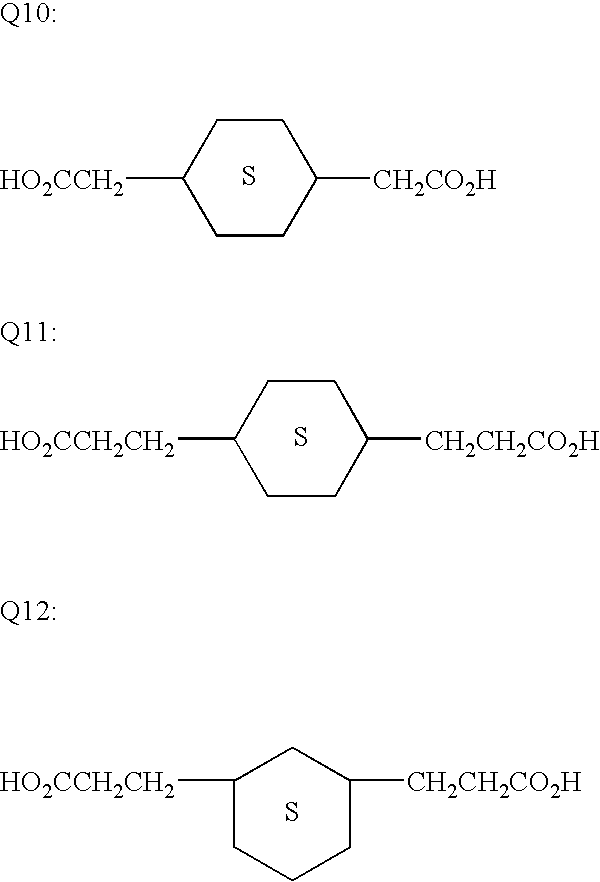Process of making an image recording element with an extruded polyester-containing image-receiving layer
a technology of extrusion and image recording, applied in the field of image recording elements, can solve the problems of insufficient stability to light fading, inability to achieve dye transfer densities, and relatively high cost of modification polycarbonates, and achieve the effect of reducing the number of polymer transesterifications, eliminating adverse reactions, and effective catalysts and stabilizers
- Summary
- Abstract
- Description
- Claims
- Application Information
AI Technical Summary
Benefits of technology
Problems solved by technology
Method used
Image
Examples
example 1
[0147]The following examples for synthesizing a polyester for use in making a dye-image receiving layer in accordance with the invention, and other polyesters may be prepared analogously or by other methods known in the art.
[0148]Polyester E-3 (having the structural formula shown above under the Detailed Description of the Invention) was derived from a 70:30 cis:trans mixture of 1,4-cyclohexanedicarboxylic acid with a cis:trans mixture of 1,4-cyclohexanedimethanol, 4,4′-bis(2-hydroxyethyl)bisphenol-A and 2-ethyl-2-(hydroxymethyl)1,3-propanediol.
[0149]The following quantities of reactants were charged to a single neck side-arm 500 mL reactor fitted with a 38 cm head and purged with nitrogen:1,4-cyclohexanedicarboxylic acid (86.09 g, 0.50 mol),4,4′-bis(2-hydroxyethyl)bisphenol-A (79.1 g, 0.25 mol),1,4-cyclohexanedimethanol (33.9 g, 0.235 mol), 2-ethyl-2-(hydroxymethyl)1,3-propanediol (2.0 g, 0.015 mol), monobutyltin oxide hydrate (0.5 g),and Irganox® 1010 pentaerythrityl tetrakis(3,5-...
example 2
[0153]Polyester E-2 was dried in a NOVATECH desiccant dryer at 43° C. for 24 hours. The dryer is equipped with a secondary heat exchanger so that the temperature will not exceed 43° C. during the time that the desiccant is recharged. The dew point is −40° C.
[0154]LEXAN 151 polycarbonate from GE and MB50-315 silicone from Dow Chemical Co. are mixed together in a 52:48 ratio and dried at 120° C. for 2-4 hours at −40° C. dew point.
[0155]Dioctyl sebacate ('DOS) is preheated to 83° C., and phosphorous acid is mixed in to make a phosphorous acid concentration of 0.4%. This mixture is maintained at 83° C. and mixed for 1 hour under nitrogen before using.
[0156]These materials are then used in the compounding operation. The compounding is done on a LEISTRITZ ZSK 27 extruder with a 30:1 length to diameter ratio. The LEXAN-polycarbonate / MB50-315-silicone material is introduced into the compounder first, and melted. Then the dioctyl sebacate / phosphorous acid solution is added, and finally the p...
example 3
[0164]To illustrate the effect of branching in the polyester according to one aspect of the invention, two polyesters were made, one with no branching agent (C-1, having the structure described above) and 2% branching agent (E-2, having the structure described above). The percentage is base on the polyol-monomer component of the polyester. These polyesters were pelletized in preparation for coextrusion by feeding them into a 27 mm LEISTRITZ compounder with a 40:1 length to diameter ratio at 240° C. The pellets were then dried at 43° C. for 16 hours, and coextruded with a tie layer consisting of a 70 / 30 polyether / polypropylene mix. The mass ratio of polyester to tie layer is 3:1, and the melt temperature was 238° C. The two layers were coextruded through a 500 mm wide die with a die gap of 1 mm. The distance between the die exit and the nip between the chill roll and pressure roll was 140 mm. A web consisting of a polypropylene laminate, tie layer, and paper also passed through the n...
PUM
| Property | Measurement | Unit |
|---|---|---|
| thickness | aaaaa | aaaaa |
| glass transition temperature | aaaaa | aaaaa |
| glass transition temperature | aaaaa | aaaaa |
Abstract
Description
Claims
Application Information
 Login to View More
Login to View More - R&D
- Intellectual Property
- Life Sciences
- Materials
- Tech Scout
- Unparalleled Data Quality
- Higher Quality Content
- 60% Fewer Hallucinations
Browse by: Latest US Patents, China's latest patents, Technical Efficacy Thesaurus, Application Domain, Technology Topic, Popular Technical Reports.
© 2025 PatSnap. All rights reserved.Legal|Privacy policy|Modern Slavery Act Transparency Statement|Sitemap|About US| Contact US: help@patsnap.com



